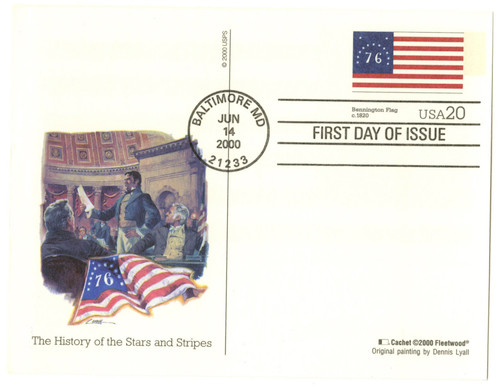
# UX323 - 2000 20c John Paul Jones Flag PC FDC
Â
Birth Of John Paul Jones
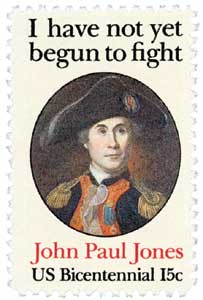
Naval commander John Paul Jones was born John Paul on July 6, 1747, in Arbigland, Kirkcudbright, Scotland.Â
Jones began his life at sea at the age of 13, apprenticing aboard a series of merchant and slave ships. On a voyage in 1768, the captain and first mate of the ship he was on both died of yellow fever. Jones successfully returned the ship to a safe port and was made the master of the ship and its crew.
During his second voyage in command, Jones flogged one of his crew who later died. He was arrested for his role in the man’s death (though he may have died of yellow fever), but later released on bail. Jones left Scotland and found a new ship, but after he killed a mutinous crewmember, he fled to America. It was at this time that he adopted the last name “Jones†to hide his identity.Â
In 1775, Jones volunteered his services to the Continental Navy. With the help of Richard Henry Lee, he was made 1st Lieutenant of the Alfred. It was aboard this ship that Jones flew the first US Grand Union Flag over a naval vessel.  Three years later, he captained the Ranger when it became the first American naval vessel to receive a formal salute from the French.Â
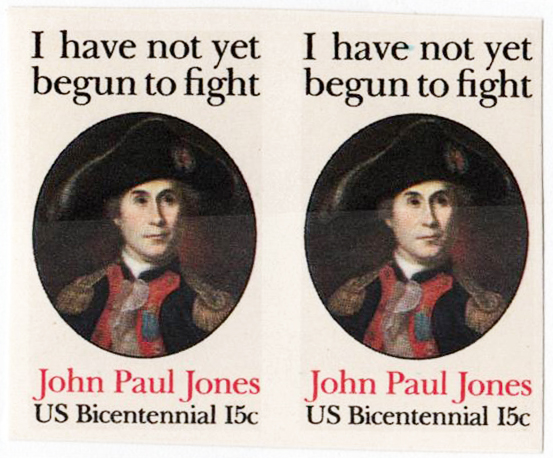
Jones repeatedly impressed his superiors in action against the British in the Bahamas as well as the Atlantic Ocean and the English Channel. In 1779, Jones was placed in command of a French merchant ship loaned to the US for the war. Jones named his ship the Bonhomme Richard in honor of Benjamin Franklin. Franklin was the American commissioner in France and author of Poor Richard’s Almanac (in French: Les Maximes du Bonhomme Richard).
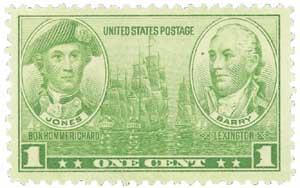
On September 23, 1779, the Bonhomme Richard was part of a convoy sailing around the British Isles disrupting shipping . It came upon the British Serapis and Countess of Scarborough near Flamborough Head, England. Around 7:00 p.m. the ships began battling. The British appeared to have the upper hand, with their ships more heavily armed. Anticipating victory, the British commander called to Jones to surrender, but Jones famously replied, “Sir, I have not yet begun to fight!â€
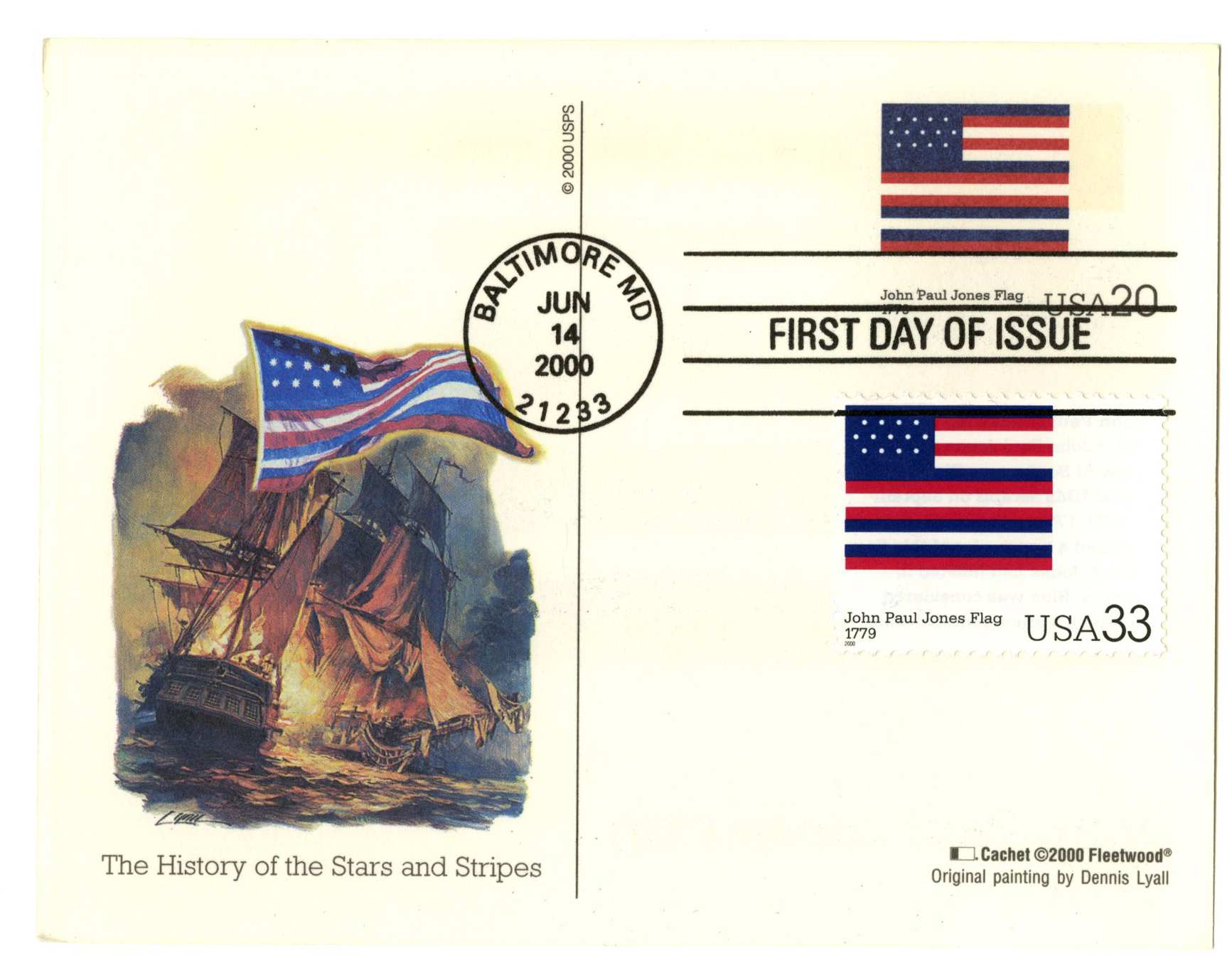
Jones then tethered the two ships together, making it harder for the British ships to get around. Though both sides had lost about half their crews, Jones still had superior numbers and used them to his advantage. When another American vessel joined the fight, Jones had the final push he needed to force the British to surrender. With his ship shattered, on fire, and leaking, Jones and his crew boarded the Serapis and sailed for the Dutch United Provinces for repairs. The Bonhomme Richard sank 36 hours later.

Captain Jones sailed his newly acquired Serapis into the neutral Dutch island port of Texel for repairs. The British claimed Jones was a pirate since the vessel he’d captured wasn’t flying a known national flag. A flag consisting of thirteen stripes, alternating red, white and blue, with thirteen white stars against a small field of blue was quickly sewn and hoisted aboard the Serapis. The Dutch recognized the flag, relieving Jones of the piracy charge. Jones’ victory made him a hero in France and America. France bestowed upon him the title “Chevalier†and the US Continental Congress awarded him with a gold medal.
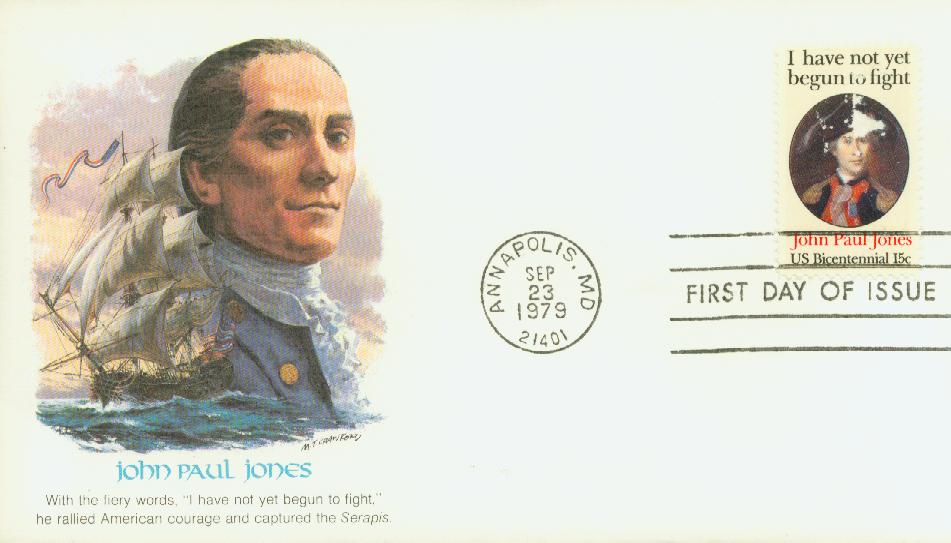
Despite his notable service, Jones soon found himself without a ship to command, as the one that was promised was given to the French. So he entered into Russian service, but faced some opposition there, as he was serving with many former British sailors who resented him. In 1790, he went to Paris and was later made US Consul to negotiate the release of American captives. However, he died on July 18, 1792, at just 45 years old. The cause was listed as interstitial nephritis, an inflammation of the kidney.Â
Â
Â
Birth Of John Paul Jones

Naval commander John Paul Jones was born John Paul on July 6, 1747, in Arbigland, Kirkcudbright, Scotland.Â
Jones began his life at sea at the age of 13, apprenticing aboard a series of merchant and slave ships. On a voyage in 1768, the captain and first mate of the ship he was on both died of yellow fever. Jones successfully returned the ship to a safe port and was made the master of the ship and its crew.
During his second voyage in command, Jones flogged one of his crew who later died. He was arrested for his role in the man’s death (though he may have died of yellow fever), but later released on bail. Jones left Scotland and found a new ship, but after he killed a mutinous crewmember, he fled to America. It was at this time that he adopted the last name “Jones†to hide his identity.Â
In 1775, Jones volunteered his services to the Continental Navy. With the help of Richard Henry Lee, he was made 1st Lieutenant of the Alfred. It was aboard this ship that Jones flew the first US Grand Union Flag over a naval vessel.  Three years later, he captained the Ranger when it became the first American naval vessel to receive a formal salute from the French.Â

Jones repeatedly impressed his superiors in action against the British in the Bahamas as well as the Atlantic Ocean and the English Channel. In 1779, Jones was placed in command of a French merchant ship loaned to the US for the war. Jones named his ship the Bonhomme Richard in honor of Benjamin Franklin. Franklin was the American commissioner in France and author of Poor Richard’s Almanac (in French: Les Maximes du Bonhomme Richard).

On September 23, 1779, the Bonhomme Richard was part of a convoy sailing around the British Isles disrupting shipping . It came upon the British Serapis and Countess of Scarborough near Flamborough Head, England. Around 7:00 p.m. the ships began battling. The British appeared to have the upper hand, with their ships more heavily armed. Anticipating victory, the British commander called to Jones to surrender, but Jones famously replied, “Sir, I have not yet begun to fight!â€

Jones then tethered the two ships together, making it harder for the British ships to get around. Though both sides had lost about half their crews, Jones still had superior numbers and used them to his advantage. When another American vessel joined the fight, Jones had the final push he needed to force the British to surrender. With his ship shattered, on fire, and leaking, Jones and his crew boarded the Serapis and sailed for the Dutch United Provinces for repairs. The Bonhomme Richard sank 36 hours later.

Captain Jones sailed his newly acquired Serapis into the neutral Dutch island port of Texel for repairs. The British claimed Jones was a pirate since the vessel he’d captured wasn’t flying a known national flag. A flag consisting of thirteen stripes, alternating red, white and blue, with thirteen white stars against a small field of blue was quickly sewn and hoisted aboard the Serapis. The Dutch recognized the flag, relieving Jones of the piracy charge. Jones’ victory made him a hero in France and America. France bestowed upon him the title “Chevalier†and the US Continental Congress awarded him with a gold medal.

Despite his notable service, Jones soon found himself without a ship to command, as the one that was promised was given to the French. So he entered into Russian service, but faced some opposition there, as he was serving with many former British sailors who resented him. In 1790, he went to Paris and was later made US Consul to negotiate the release of American captives. However, he died on July 18, 1792, at just 45 years old. The cause was listed as interstitial nephritis, an inflammation of the kidney.Â
Â












